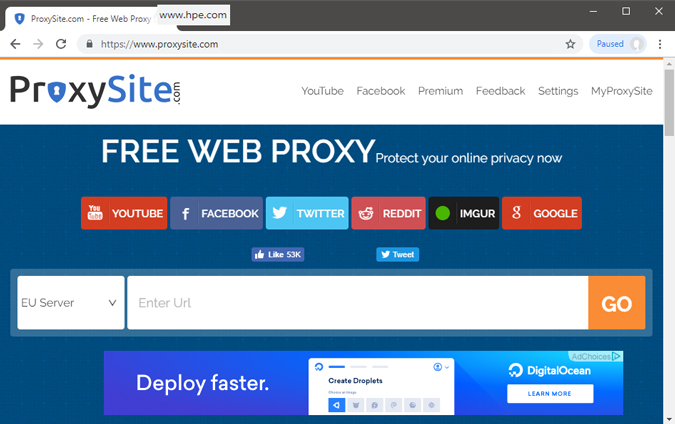Internet censorship is very common across the world wide web. Governments do it to restrict citizens from watching content they find inappropriate. Even offices and colleges block websites they do not like. Of course, sometimes it is necessary to block some websites. But often, most offices and collages block useful and legitimate websites without any good reason. Sometimes internet censorship is justified but usually, it’s the misuse of power.
The internet is an excellent place to learn new stuff. People like me even make a living out of it. Needless to say, it is one of the best things in my life. But it would never be possible if I didn’t have access to the internet. The Internet is a free place and it should be kept like that.
On that note, here are some tips and tricks to access blocked content. However, some countries/institutions are strict about internet censorship. So if that’s your case, then beware of the consequences.
Related: How to Access Torrents Blocked by Your ISP

6 Simple Hacks To Access Blocked Websites
1. Start Simple
If the website is not opening, try replacing ‘http‘ with ‘https‘ in the URL.

This worked flawlessly on my college WiFi, which has banned Facebook and several other social media sites. If you get SSL error saying, the website is not trusted. Click on the proceed anyway button.

Another small trick that you should try before pulling the big guns is using URL shortening service. Try this website for URL shortening.

However, most institutions are smart enough for this. So don’t expect it to work everywhere.
Related: How to see the blocked content on Websites
2. Use a proxy website
If the above method didn’t work for you, proxy websites should. Google the keyword ‘proxy websites.’ Open the first link and enter the URL of the blocked website and click on Go. The proxy website will fetch the blocked content for you.
How do proxy websites work?
The concept is simple. a proxy replaces your IP with their own. So instead of directly requesting the page, you send a request to the proxy website first and then it forwards your request to the blocked website.
However, your institution can easily block the proxy website as well. So the least popular the proxy site is, the more are the chances that it will work.

Or Use Google Translate
It may sound crazy but believe me, you can use Google translate as a proxy site. The best thing about using Google as your proxy is that most institutions don’t block Google translate.
So, head over to the Google translate website. In the translate box, type in the URL of the blocked website and convert it to some local language you know. Unfortunately, they have removed translate to the same language feature.
Or, Use Google Cache
Well, this is one of the lesser known methods and is very similar to Google Translate method. The best thing about this method is that is easier than Google Translate and works like a charm. To access a blocked website, simply search the website in Google Search. Once you get the search results, click on the green arrow beside the link and select “Cached”. This will load the cached web page of the said URL.

Just like with Google Translate, this method also has its limitations like:
- It will load the webpage that is cached by Google Search Engine. So, what you are seeing may not be the latest information.
- The webpage may not load CSS styles. So, you will be just seeing regular text and images without any formatting or styles.
However, Google Translate or the cache method doesn’t work with dynamic websites like Facebook or YouTube. So for that, use the next approach.
3. Browser extension
To access geo-restricted websites like Pandora and Spotify, you can use browser extensions like TunnelBear or Zenmate. To get this extension, do a simple Google Search and install it from the store. Sometimes, you might need to create an account to use them. TunnelBear only gives you 500 MB of free data every month. Now, this is sufficient for text browsing. But say if you use tunnel bear to watch US Netflix content or any video content for that matter, then all your free data will be gone in a single session, right?
Well, there is a small trick to solve this issue. Most services only check your IP when you log in for the first time or when you start playing the video. So once you are in, you can simply turn OFF the VPN service. I personally tested this method for Spotify and Netflix from India and it worked just fine.
Netflix has launched nearly in 130 countries, but its content is not equal everywhere even though it charges the same. To access all the Netflix content in one app, use Smart DNS Proxy. It’s a paid VPN that remove geo-restriction from Netflix and several other videos sites such as Hulu, BBC UK, Pandora etc.

Related: How to use Spotify Outside the US and UK (with Video)
4. Access Blocked Websites in Android
If you are using Android on a restricted Wi-Fi network, then use Orbot. It’s an Android client for famous Tor browser. All you need to do is turn on Orbot and it will configure everything for you. Tor is based on onion routing protocol i.e. it has 3 layers of protection and it is also open source. So you can use it to access any blocked websites without worrying about if someone is keeping your logs.
However, since it is routing your traffic through 3 different computers located across the world, the speed you get will not be that good. It is good enough for text-based browsing and emails, but for videos or file sharing, you will have to wait a lot. Moreover, while no one can see what you are browsing and watching while using Tor network, if the system admin or ISP is good enough, he can still see that someone is using a Tor client to mask their activities on the network.
Download Orbot

5. VPN Apps
Proxies are good for browsers. But if you want other apps like uTorrent or Skype to work on a restricted network, then what you need is a VPN. Moreover, unlike proxies, it is difficult for an ISP to block a VPN connection. The reason being, unlike proxies, VPNs are not public and the connections are encrypted. So, it is near impossible to monitor and very difficult for ISPs to block a VPN connection.
The only downside of VPN is they are paid services. But you can find some free ones out there like Tunnel Bear or Hotspot Shield. In return, they will either show you ads or you get a limited bandwidth. Don’t expect torrents to work with a free VPN, though.
In the video above, I have shown how to install and use a free VPN like Hotspot Shield. In case you didn’t watch the video, all you have to do is download the free version of Hotspot Shield, install it on your computer and that’s it. The program will automatically start the service.
Related: Best Free VPN Apps We Recommend at TechWiser

6. Change your DNS to SmartDNS
This is the ultimate solution. By default, we use the default DNS (short for Domain Name Server) provided by our ISP. In case you don’t know, DNS is the one that is responsible for resolving the IP address from the web address you typed in the address bar. Here is a detailed article on What is DNS and What DNS Server you are using. However, since everything happens in the background, we never notice it.
As the default DNS services are provided by your ISP, they can easily monitor and block the requests and make the website you are trying to access unreachable. In those situations, you can use services like Smart DNS Proxy. When using Smart DNS Proxy, you are provided with a different set of DNS addresses. When you use these addresses, you can unblock everything i.e. websites and streaming services like Netflix and even torrents. The good thing is, Smart DNS proxy has a very detailed guide on how to change DNS address on various systems like Windows, MacOS, Android, and even on routers.
The advantage of using the DNS method is that since you can change the DNS settings on the router level, all your devices like smartphones, computers, and even Chromecast will work without any additional configuration. Also, the DNS method is faster than your regular VPN. But here’s the bummer, Smart DNS Proxy is a paid service that costs $5 per month. So if you want to go that route, you can try Smart DNS Proxy or UnlockUS. Both are good and offers a free trial with no credit card requirement
Related: How to change DNS on every platform

Access Blocked Websites
But the most effective way to hide your identity is to use Tor. I use this all the time in my college. The only downside is, when you access torrents or YouTube, the connection is very slow. But hey, you can access any blocked websites, right?
Related: How to use Tor Browser Bundle
So which method looks most promising to you? Share your thoughts and let me know if you have any question via comments.